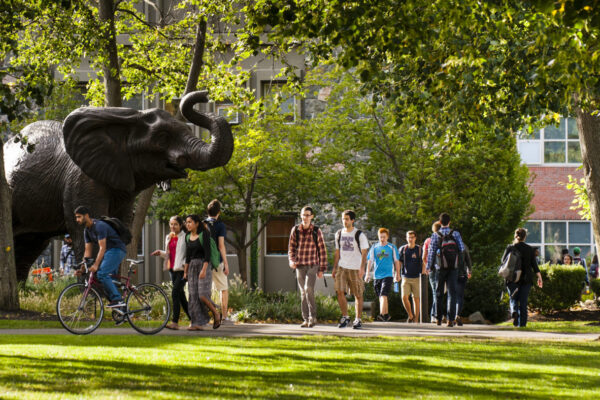By Carol Anderson and Patricia O’Brien

Accreditors are often criticized for not “clamping down” on institutions with low graduation rates. Some commentators even propose that accreditors should “yank the accreditation” of those institutions that receive federal student aid but graduate, in some instances, less than 10 percent of their first-time, full-time student body. In fact, accreditors do work closely with these institutions, but stories about continuous improvement and moving the needle on graduation rates don’t grab the headlines in the same way as an institution that reports a 5 percent graduation rate.
In fall 2016, the Council of Regional Accrediting Commissions (C-RAC), which is comprised of the seven regional accrediting commissions across the country, developed an initiative to address the issue of low graduation rates at our institutions. Given the diversity among the seven regions, C-RAC determined that each region would establish its own process for addressing this matter with four-year institutions that have IPEDS graduation rates at or below 25 percent over six years and two-year institutions that have rates at or below 15 percent over three years.
Our accrediting agency, the Commission on Institutions of Higher Education in New England, implemented the Graduation Rate Information Project as our part of the initiative. The presidents of the 28 New England institutions that met the low graduation rate criteria outlined above were asked to submit a seven-page report responding to the data, including other information about retention and graduation rates for their students and detailing the plans and strategies in place at their institution to address this issue. A Graduation Rate Information Project Committee comprised of five college presidents (two of whom serve on the Commission), two academic officers and one director of institutional research was established to review the reports.
When the committee met in March 2017, it identified three common themes across institutions: 1) the student population is largely non-traditional; 2) graduation rates are well above the IPEDS rates when all students are considered; and 3) institutions are working very hard to improve graduation rates.
Non-traditional student populations: The majority of the 28 institutions are community colleges and adult-serving baccalaureate institutions. Not surprising, the student populations attending these institutions are overwhelmingly non-traditional: average age ranging from 25 years to 35 years; transfer students; low-income students; adult learners who work full-time and care for dependents; underrepresented students; first-generation students; students for whom English is their second language; and students who do not expect or intend to graduate within three or six years. The vast majority are not the first-time full-time students captured by the traditional IPEDS rates.
Graduation rates are well above the IPEDS rates: When an institution has a part-time student population of well above 75 percent, the IPEDS graduation rate represents an insignificant segment of the total student population. In one institution, the 20 percent IPEDS graduation rate was based on six students; the 14 percent rate at another college was based on seven students. Another institution verified that its 9 percent IPEDS graduation rate is correct; however, the rate reflects only 11 students, or 5 percent of the 209 students in that cohort. When all 209 entering students were included, the six-year graduation rate climbed to 47 percent. A third institution reported that its most successful population—nursing students—are seldom captured through IPEDS, as most of these students study part-time. Of the 51 nurses who graduated from this institution in 2015, only 10 were first-time, full-time students. Nursing students at another institution start their program in the summer, so students in this highly successful group are never captured in IPEDS data. In several instances, when measures of student success included students still enrolled and students who transferred out, graduation rates exceeded 50%.
In sum, IPEDS graduation rates are not—and probably never will be—higher at these institutions because they enroll so few first-time, full-time students. Graduation rates increase significantly when all full-time and part-time students are included.
Institutions are using innovative approaches to improve: Most of the low-graduation rate institutions in New England have a deep understanding of their student population, and these institutions are highly committed to improving student success. Virtually all institutions are participating in state-based grant programs and/or federal grant initiatives such as the Title III grant program designed to expand capacity to serve low-income students, or American Association of Community College initiatives such as Voluntary Framework of Accountability and Achieving the Dream. Increasingly, institutions are submitting data to the National Student Clearinghouse (NSC), and using NSC data to track students who have transferred to or graduated from other institutions. Many are participating in the Student Achievement Measures (SAM) initiative,** an improved way to report undergraduate student progress and completion by including a greater proportion of students and tracking students who enroll in multiple higher education institutions.
The committee learned that while institutions varied on the extent to which they are implementing general strategies to improve overall retention and graduation rates, many institutions are highly successful in serving specific segments of the population. Several community colleges boasted course completion rates of 81 to 87 percent for high school students in dual enrollment programs. Another institution reported that students in its welding program were in such high demand among employers that the best students were hired out of the program before they graduated; paradoxically, it was often the least successful students who graduated. Similarly, a community college graduates a class from its advanced manufacturing machine technology certificate program with a 100 percent job placement rate every semester.
Each institution also cited multiple student success initiatives that are either already in place or that will be implemented in the coming months, including: community-based initiatives; enhanced academic and student support services; intrusive advising programs; Degree Works; Guided Pathways, mandated student orientations; mentoring programs; hiring additional faculty in critical areas such as ESOL, math, and English; grade warning systems; and summer programs. Several institutions had established innovative approaches to improving student success, such as “philanthropic partnerships” to fund student success initiatives; programs aimed at improving retention and graduation rates among specific at-risk populations; stackable credentials; reverse transfer programs; and articulation agreements.
*****************
The Graduation Rate Information Project Committee and the Commission concluded that the 28 institutions in this study are keenly aware of their graduation rates, and they are working diligently to improve. Many of the institutions had identified graduation rates as an area of concern in self-studies or other accreditation reports, and the strategies they have implemented are beginning to gain traction.
In other cases, the Commission is monitoring the progress of institutions that are in the early stages of their student success strategies, as it will take time to realize the results. The Commission initiated further monitoring regarding low graduation rates from two of the institutions. It will repeat this initiative next year for any institutions that meet the criteria in 2017 but were not identified through the 2016 data.
Each regional accreditation agency is taking a different approach to the Graduation Rate Information Project, primarily because of differences in size and composition of institutions within the region but also to gain multiple perspectives on this issue. Later this year, C-RAC will meet to discuss the findings of their individual projects.
**SAM is an initiative of six higher education associations, supported by the Bill & Melinda Gates Foundation and the Carnegie Corporation. See: www.studentachievementmeasure.org
If you have any questions or comments about this blog post, please contact us.




